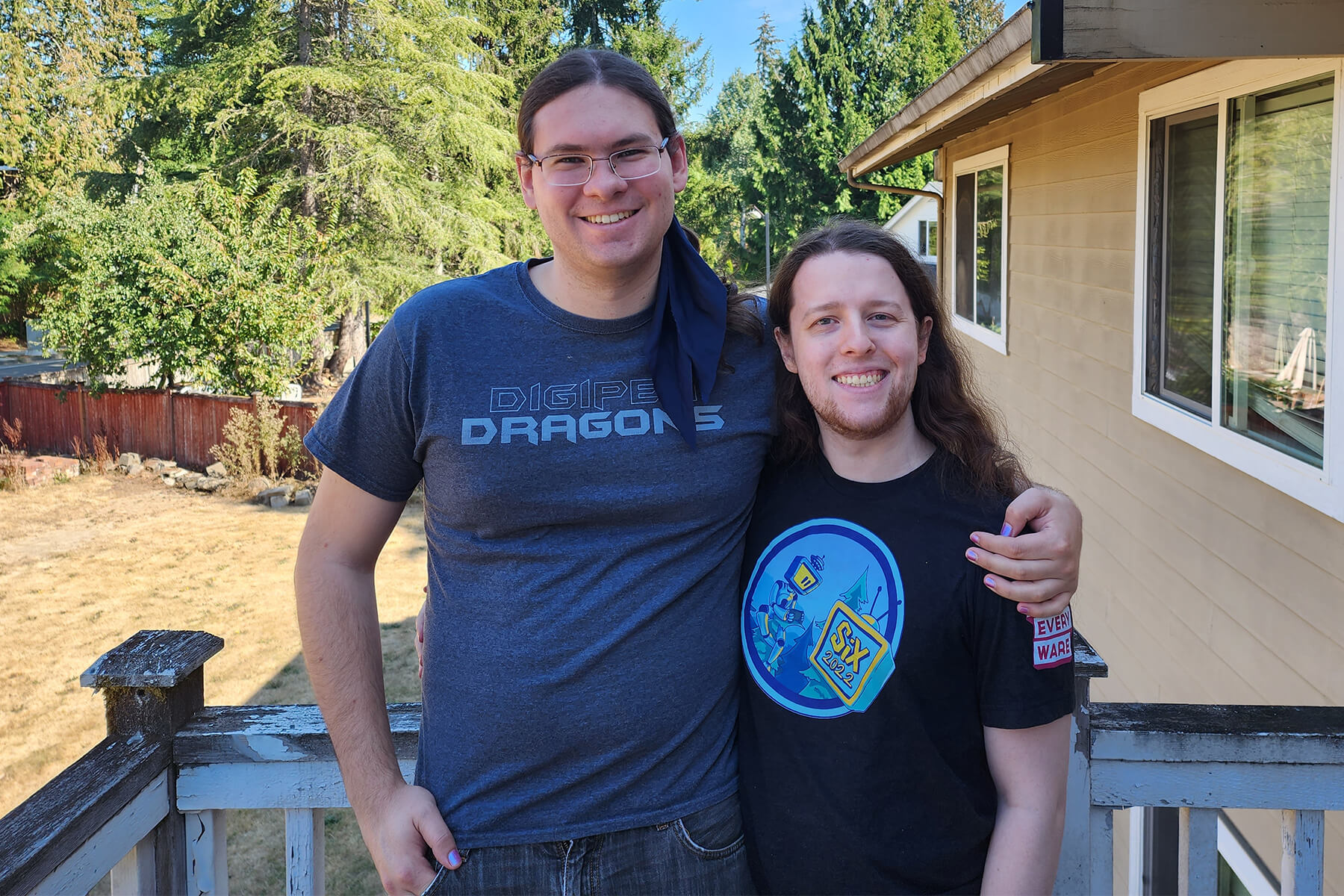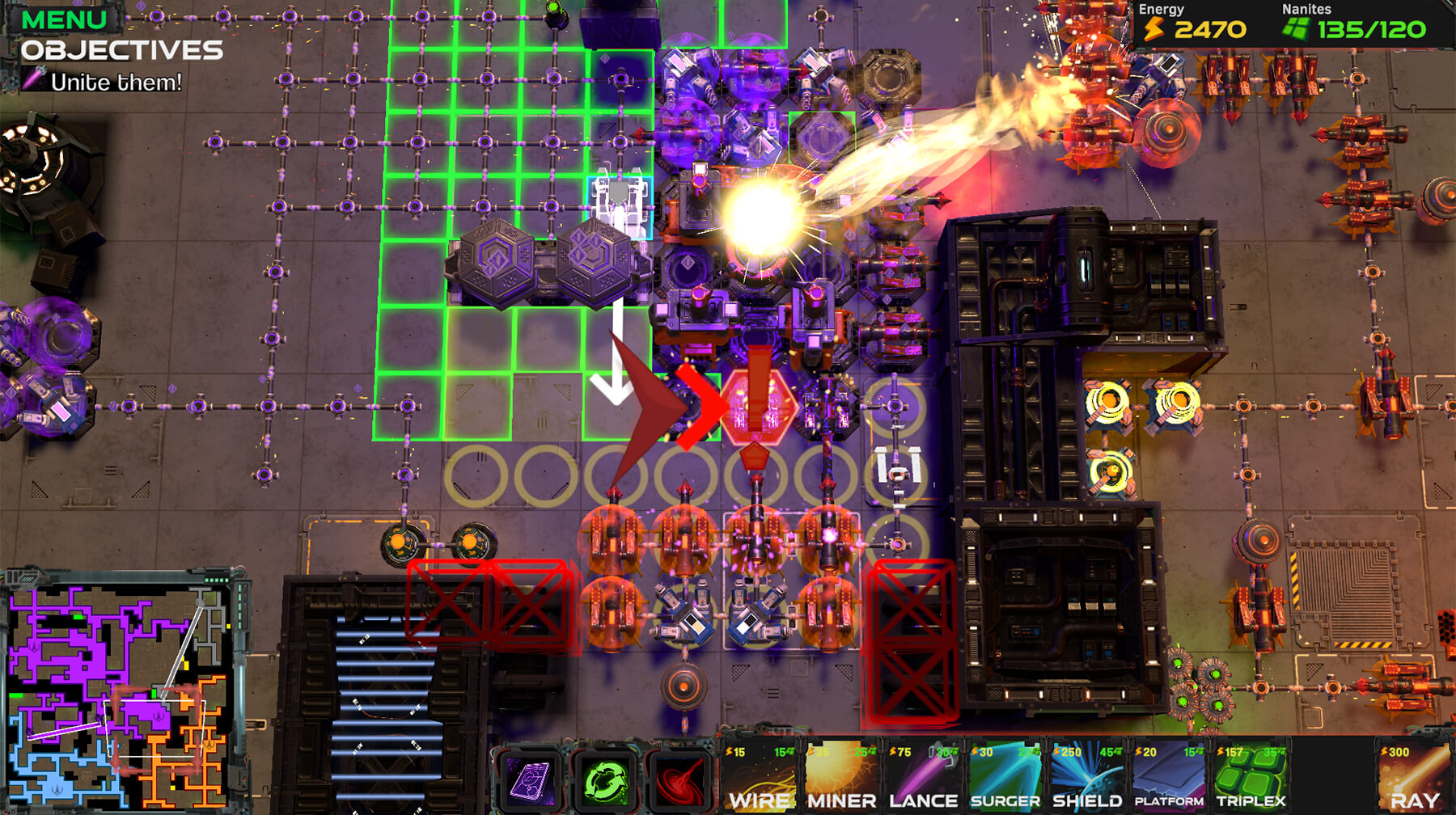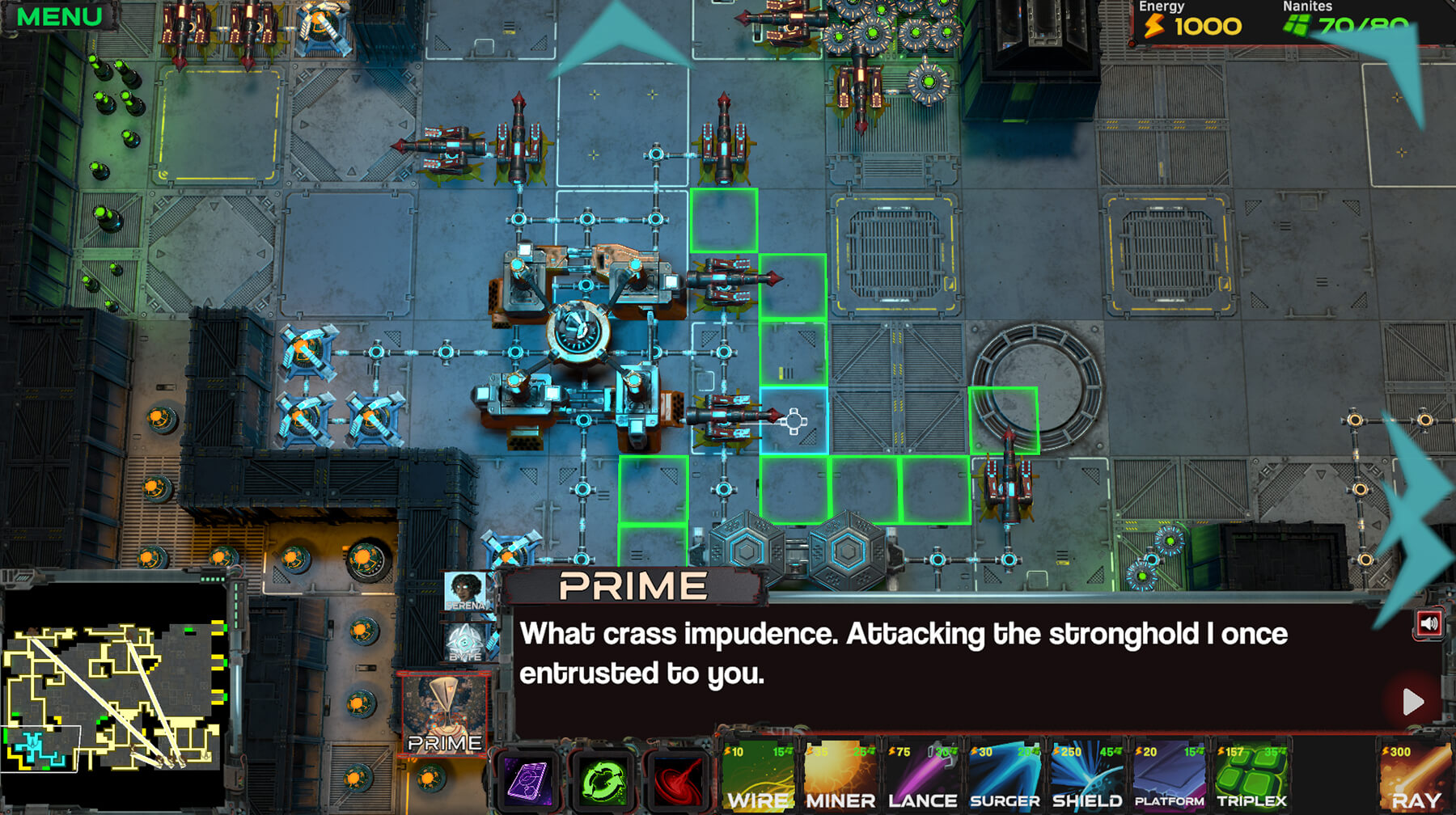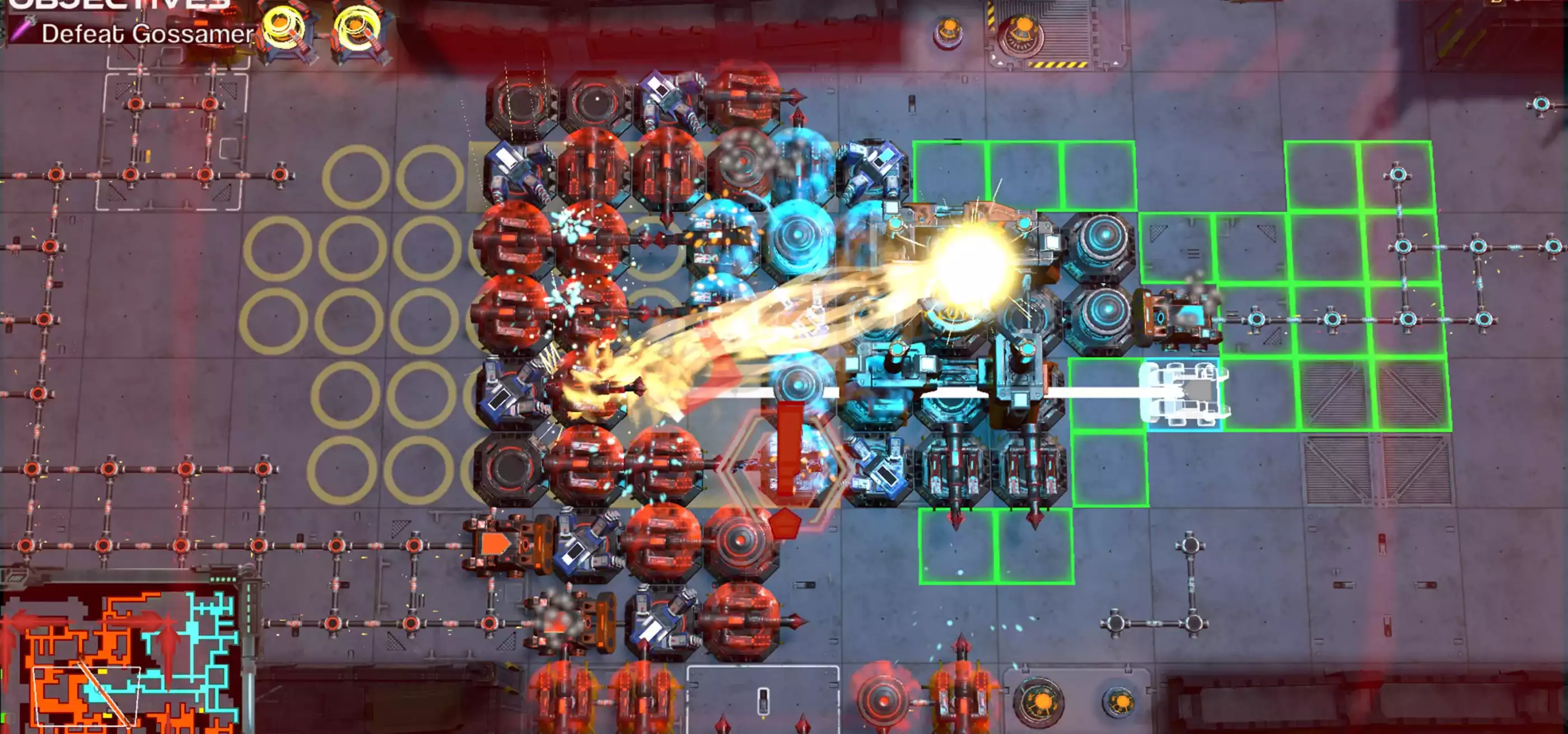When the sci-fi real-time strategy Byte Lynx comes out, Tucker Bane will likely be one of the very few players overjoyed to lose the game.
“It’s pretty great!” he says. “I’m thrilled when the game beats me. When the AI plays better and faster than me, it feels so nice!” That’s because Bane has spent the past year and a half developing the cunning AI to challenge players in the dynamic world of the game, the debut title from his and fellow DigiPen graduate Micah Rust’s two-person studio, Artful Games.
Out October 12 on Steam, Byte Lynx puts a unique spin on the RTS genre. Unlike most RTS games, which have players managing and controlling various clusters of fighting units, all combat centers around construction.
The seed that turned into Byte Lynx actually came from Rust’s 2014 freshman DigiPen game, Encroach. “We wanted to combine the simple, elegant depth of games like Go with the progressive player dynamics of modern games like League of Legends,” Rust says. “The original design for Encroach was a lot bigger and more expansive than what we released. I had ideas exploring that design space further rattling around in my head for years and years afterwards.”
To Rust, a 2018 BS in Computer Science and Game Design graduate, Encroach’s main mechanic held lots of untapped potential. Two players vie to destroy each other’s headquarters, which also double as the power source for each team’s buildings. All buildings must connect back to HQ by constructing wires, which themselves can be attacked, cut off to remove ownership, and rewired to strategically capture anything an opponent built on them. “I kept building around this shell of an idea over time, going, ‘Oh man! Someday I’m going to do this,’” Rust says. “Then eventually I just realized that now was the time.”
Although Rust and Bane never worked on the same game team during their DigiPen careers, they became close as college roommates, forming a lasting friendship around their shared love of RTS games. “Blizzard RTS games were probably my biggest gaming inspirations growing up,” Bane, a 2018 BS in Computer Science in Real-Time Simulation graduate, says. “StarCraft was the second video game I ever played after Chess Mates.” Rust similarly sums up his youth with a long list of classic RTS titles like Age of Empires, Outpost 2, and of course, StarCraft.

“We had both always talked about how it would be really cool to ship an RTS game on Steam one day,” Rust says. “Eventually, we both had life circumstances that gave us that opportunity.” After arriving at points in their post-graduate careers where a break felt natural, Rust and Bane decided to make a go for it and co-founded Artful Games in July of 2021. “We spent six weeks expanding out ideas from Encroach, trying to make something new and fun, and we tested it out to see if people liked it,” Rust says. The positive early response the two received was great encouragement to continue evolving their ideas, playing off the game’s core mechanic of connectedness.
One big inspiration in developing Byte Lynx was an attempt to solve a common problem Rust and Bane saw in other RTS games, something they dub, “The Deathball.” “You expand your resources, build up an army, and then you just kind of throw it at the enemy. And if you have more stuff, you win,” Bane says. “There’s a lack of finesse there that means the terrain doesn’t matter much.”

Byte Lynx, on the other hand, is “unit free,” and all combat is construction based. The only way to move around the map is by building out your HQ-connected wire network and constructing things on it, or by building movable platforms under existing buildings that can then be pushed around. “When you restrict how players can move around the map, it makes positioning much more important,” Bane says. “Our game does the extreme version of that, where it actually costs you resources to move from one place to another.”
In only a year and a half, Bane and Rust developed the 20-mission single-player campaign that forms the core of the game, an impressively quick turnaround they credit to their shared vision. “Being on a small development team and being really keyed in to those core design pillars has helped so much,” Rust says. “We haven’t had to remake our game a ton of times.”
Another huge help? Knowing how to scope their game, something they credit to their years of developing student game team projects. “DigiPen project classes and their hard deadlines really give you the discipline to ask yourself if a feature is truly important and be honest with yourself about it,” Rust says. “One of the reasons we were able to ship a game in a year and a half is because we found out which parts of Byte Lynx were actually awesome and vital to the experience, and we just worked on those.”

That’s not to say developing Byte Lynx wasn’t immensely challenging at times. “We’re crazy people for making our first professional game an RTS,” Rust says. “Next to an MMORPG, making an RTS is the hardest genre you can make.” A major battle the two immediately faced was the notable lack of third-party engine support for the niche genre, one they were already taking into uncharted territory with their no-units approach.
“We could have a thousand or more buildings all at once, each of which could have unique health, could be attacking something — just tons of different data states modifying other bits of data constantly,” Rust says. “Being able to have systems that scale to that, it’s very difficult to find anything off the shelf. So, you have to build everything yourself, and you have to build it so it can handle a thousand buildings.”
On that end, their college education came in handy very quickly. “Fortunately, we’re both DigiPen grads, so we’re used to building engines from scratch!” Bane says. “All that engine architecture stuff really helped.”
Byte Lynx’s story follows a spacefaring captain who crash lands on a mysterious, mechanical planet full of hostile alien AI. Developing that AI was another formidable challenge for the team. “For most games, enemy AI is very simple and concrete — they need to navigate paths, move towards the player, and attack,” Bane says. “In an RTS, not only does the AI need to appear smart and strategic, it has to do so in an environment that is constantly changing based on what the player has built, and react to it.”
Fortunately, we’re both DigiPen grads, so we’re used to building engines from scratch!
So far, people’s reactions to what Artful Games has built has been a huge reward for the two developers. “My most common pride moment is whenever we accidentally trick someone into thinking we’re a AA studio that has made games before,” Bane laughs, recalling a few such moments at the recent Seattle Indies Expo.
“We’re two people, no artists, first game, no publisher, but it’s fun when people think we’re much more than that just from seeing the game,” Rust says.
Now that Byte Lynx is gearing up for its release on Steam, the two are eager to see how their passion project is received. But at the end of the day, the biggest reward is simply getting to experience their dream game made manifest — along with the unexplored strategic depths it contains. “When I’m playing it fully engaged and get into that flow state you get with a good game, I just feel so happy we were able to make this,” Rust says. “I actually tried a new playstyle the other day and was shocked at how good it worked … a little too good. I realized I needed to nerf something.”
